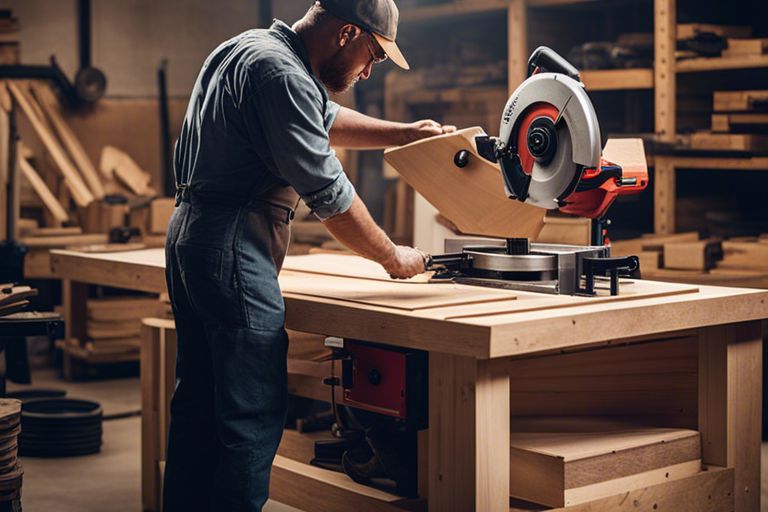Your In-Depth Guide to Selecting the Ultimate Circular Saw for Mastery in Woodworking
Selecting the right circular saw can make a world of difference in your woodworking projects. With a plethora of options available, it can be overwhelming to choose the perfect one for your needs. This comprehensive guide will walk you through everything you need to consider when selecting the ultimate circular saw to enhance your woodworking skills and achieve mastery in your craft. Whether you are a beginner or a seasoned woodworker, this guide will help you make an informed decision and level up your woodworking game.
Contents
Understanding the Types of Circular Saws
A circular saw is a versatile power tool that comes in various types to suit different woodworking needs. Understanding the differences between these types can help you make an informed decision when selecting the ultimate circular saw for your projects. Here is a breakdown of the main types of circular saws:
| 1. Corded Circular Saws | 2. Cordless Circular Saws |
| 3. Sidewinder Circular Saws | 4. Worm Drive Circular Saws |
| 5. Hypoid Circular Saws | 6. In-Line Circular Saws |
Cordless vs. Corded Circular Saws
Clearly, choosing between a cordless and corded circular saw depends on your mobility needs and power preferences. Cordless saws offer portability and convenience, while corded saws provide consistent power for heavy-duty tasks. Consider your workspace and project requirements when making this decision.
Sidewinder vs. Worm Drive Circular Saws
Even though both types are popular choices for woodworking, the main difference lies in their design and power delivery. Sidewinder saws are compact and lightweight, making them ideal for everyday tasks, while worm drive saws are known for their torque and durability, suitable for heavy cutting applications. Choose based on the specific demands of your projects.
Circular saws can be categorized into either sidewinder or worm drive designs, each offering unique advantages. Sidewinder saws have the motor positioned alongside the blade, allowing for a more compact and lightweight design, making them well-suited for tasks where maneuverability is key. On the other hand, worm drive saws feature the motor at the rear of the tool, providing more torque and power for heavy-duty cutting applications. Consider the nature of your woodworking projects to determine which type of circular saw best fits your needs.
Hypoid vs. In-Line Circular Saws
One of the less common types of circular saws, hypoid saws are known for their efficiency and reduced maintenance requirements compared to traditional worm drive saws. In-line circular saws, on the other hand, offer a compact and lightweight design similar to sidewinder saws but with a more direct power transfer mechanism. Consider the specific benefits of each type based on the demands of your woodworking projects.
In-Line circular saws provide a more direct transfer of power from the motor to the blade, resulting in increased efficiency and torque compared to traditional sidewinder or worm drive designs. This makes them a preferred choice for users looking for a balance between power and maneuverability. Hypoid saws, on the other hand, offer similar benefits to worm drive saws but with a more efficient gear system that reduces maintenance requirements. Depending on your woodworking needs, either of these types may provide the performance and reliability you are looking for.
Essential Tips for Choosing the Right Circular Saw
Some imperative tips to consider when selecting the right circular saw for your woodworking projects include:
- Identifying your woodworking needs
- Considering the power source and motor type
- Evaluating the blade size and type
Recognizing these key factors will help you make an informed decision and enhance your woodworking skills.
Identifying Your Woodworking Needs
Your woodworking needs will dictate the type of circular saw that is best suited for your projects. Consider the size and scope of your typical projects, as well as the materials you work with most frequently, to ensure you choose a saw that meets your requirements.
Considering the Power Source and Motor Type
Essential to choosing the right circular saw is considering the power source and motor type. With corded and cordless options available, evaluate your need for mobility and power to determine which type of saw will work best for your woodworking projects.
Evaluating the Blade Size and Type
Now, assessing the blade size and type is crucial in selecting a circular saw. The size of the blade will impact the cutting depth and efficiency of the saw, while the type of blade will determine its compatibility with different materials and cutting tasks.
To enhance your woodworking mastery, carefully evaluate these factors when choosing the ultimate circular saw for your projects.
A Step-by-Step Guide to Selecting the Ultimate Circular Saw
Researching and Shortlisting Options
| Analyze Your Needs | Consider the type of woodworking projects you do and the power and features required. |
| Explore Brands and Models | Research reputable brands and models, considering factors like durability and customer reviews. |
Comparing Features and Specifications
| Weigh Power and Blade Size | Ensure the saw has sufficient power and blade size for your projects. |
| Check for Adjustable Bevel and Depth | Look for saws with adjustable bevel and depth settings for flexibility in cutting different angles and depths. |
For a thorough comparison, make a list of features and specifications that are necessary for your woodworking tasks. These may include motor power, blade size, bevel capacity, cutting depth, and additional features like laser guides or dust collection systems.
Reading Reviews and Asking for Recommendations
Any circular saw that catches your interest, be sure to read reviews from verified buyers to gain insights into real-world performance and durability. Additionally, asking for recommendations from fellow woodworkers can provide valuable firsthand information.
Step-by-Step, take the time to thoroughly research, compare features, and gather feedback before investing in the ultimate circular saw for your woodworking mastery. Your selection process will ensure you find a tool that meets your specific needs and helps you achieve woodworking excellence.
Critical Factors to Consider When Buying a Circular Saw
To ensure you make the best choice when selecting a circular saw for your woodworking needs, there are several critical factors you need to consider. These factors will help you narrow down your options and find the ultimate circular saw that will enhance your woodworking skills.
- Blade Size
- Power Source
- Safety Features and Ergonomics
- Durability and Build Quality
- Weight and Portability
Safety Features and Ergonomics
Little details like blade guards, trigger safety locks, and ergonomic handles can make a big difference in ensuring your safety and comfort while using a circular saw. Look for saws with features that prioritize user protection and ease of use to prevent accidents and reduce fatigue during long woodworking sessions.
Durability and Build Quality
If longevity and performance are vital to you, prioritize circular saws made from high-quality materials and with solid construction. Look for saws with durable components that can withstand heavy use and tough materials, ensuring your investment will last for years to come.
A circular saw with sturdy aluminum or magnesium components and a robust motor is more likely to handle challenging tasks and provide reliable performance over time.
Weight and Portability
Build a circular saw that strikes the right balance between being lightweight for easy maneuverability and sturdy enough for stability during cutting tasks. A saw that is too heavy can cause strain and fatigue, while one that is too light may lack stability and precision.
Weight distribution and the inclusion of features like carrying handles or ergonomic grips can also affect how easily you can transport and handle the circular saw on job sites or in your workshop.

Weighing the pros and cons of each popular circular saw brand is crucial in selecting the ultimate tool for your woodworking projects. Consider your specific needs, budget, and preferences to choose a brand that aligns with your woodworking goals.
Summing up
Considering all points discussed in this in-depth guide, selecting the ultimate circular saw for mastery in woodworking involves careful evaluation of blade type, motor power, ergonomics, safety features, and additional functionalities like bevel capacity and dust collection. By understanding your specific woodworking needs and budget constraints, you can confidently choose a circular saw that will enhance your woodworking skills and projects. Be mindful of, the right tool can make all the difference in achieving precision and efficiency in your woodworking endeavors.



